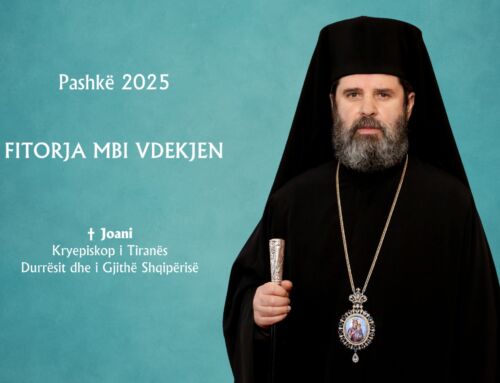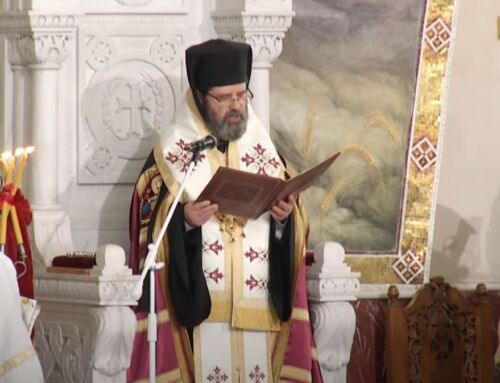The promotion of the complete liturgical music book titled Anastasimatari, which was adapted and composed in Albanian by Theodhor Peci, Director of the School of Byzantine Music of our Church and leader of Byzantine Choir of Chanters “St. John Kukuzeli”, took place on Wednesday, December 16, at the Hall of the Cultural Center of Orthodox Cathedral “Resurrection of Christ”, in Tirana, in an atmosphere of Byzantine Music resurrection sounds in front of a large audience, believers, music specialists, MPs, diplomats, etc.
Anastasimatari or “Ngjallësori” in Albanian is the basic psaltic book, containing mainly stichera of octoechos, with all those considered as such, such as the stichera of Anatoli, dogmatic stichera according to the alphabet by Joan Damaskinoi, dogmatic Theotokion, eleven matinal doxastika by Leonty the Wise and the hymns of ascent (anabathmoi of oktoechos).
The program, moderated by the musician Michaela Minga, began with the presentation of four keynote speakers, Academician Vasil Tole, Mrs. Meri Kumbe, Professor of Byzantine Music at the University of Arts, prof. Dr. Grigorios Stathis, Director of the Institute of Byzantine Musicology of the Holy Synod of Greece and Dr. Grigorios Anastasiou, Scientific Collaborator of the Institute.
In his speech, Mr. Tole stressed the importance of the book as part of the revival of the Orthodox Church, as well as the value of the introduction of Albanian language by Bishop Theophan Noli and other precursors, in Christian psalmody. He said: “If today we confidently state that the holy word in Albanian was neatly brought by Bishop Fan S. Noli, henceforth we will add another truth to this truth, that the word and music together … was brought to us by Theodhor Peci through Anastasimatari, a standardized melodic document in Albanian of both Byzantine music morphologyand liturgy performed in the Orthodox Autocephalous Church of Albania, and was prepared by him with love and high competence.”
Whereas the second speaker, Ms. Kumbe, gave an overview of the history of Psaltic Art in Albania, which is divided into three major periods, the period of manuscripts which can be found in the Central State Archive, the Renaissance and formation of the Albanian state with representatives such as Fan Noli, Dhimiter Beduli, Kostandin Trako, Spiro Konda, Sotir Kosmo etc. and the third period after the fall of communism with Fr. Justin Anthimiadhi, Fr.Damaskin Grigoriati, His Grace Ignatius, Metropolitan of Berati, Fr. Spiro Kostoli, Harallamb Terziu, Theodhor Peci etc.
Subsequently, the keynote speaker, Mr. Stathis, described the complete Anastasimatari in Albanian as “… the historical event, which inaugurates a series of similar publications which, by the grace of God, will follow in order to properly perform the hymns of worship in the Orthodox Autocephalous Church of Albania but also wherever Albanian hymns are chanted”. He pointed out that “language and psalmody are inseparable from each other” and that the Orthodox Church acknowledged the many languages and the need to worship God in the solemnities of “each one’s mother tongue”. Then he analytically elaborated the three components of melody namely, “the word – as the body and life; melody – like a coating honored and appreciated; and rhythm – as permanent and harmonious movement, which are inherent and co-existent and constitute “the holy trinity” of Psaltic Art. When the chanter knows well these three elements – and he should know them indeed “if he does not want to be just a chanter by name”(Gabriel, the Hieromonk),- then he is free and able to process and refine, where necessary, the given musical material inherited from the past, in a way that no matter in what language it is chanted, it can take its perfect form when coated with the precious garments of melody and the natural fluency, in spite of the multitudes of its rhythm.
And based on this knowledge, he would be able to use the appropriate melodic phrases (thesis) for every word and meaning in the source language, which can either be preserved, or transferred, and their sound be heard as beautiful in any target language. Proficiency makes the chanter a melodist, a wise user of tradition and a creative composer, because tradition is always the starting point and the strength for new creations.”
The fourth speaker, Mr. Anastasiou, focused mostly on the structure of Anastasimatari and how it was compiled in Albanian. He stressed that “The work of adapting psaltic melody into another language, first requires excellent skills of both languages, very good knowledge of the functioning of musical writing and orthography as well as both musical sensitivity and compositional skills based upon composition rules, because as we know, adjusting a musical piece is more or less like creating a new composition. All that I mentioned above are very brilliantly handled by Mr. Theodhor Peci. His work is both an adaptation and composition, because he retained, where it was possible, the classical tunes of Petro Peloponnese’s and Joan Protopsalti’s “Anastasimatari” , but when the musical coating did not fit the body-that is, the word, he intervened to give us a new composition. Moreover, every composer gives priority to the musical coating of the word and does his best. And let’s also mention that Anastasimatari, which you hold in your hands, is not simply a product brought out of individual or laboratory work. This book is tested every day as the main teaching manual of Psaltic Art at the Byzantine Music School of the Archdiocese of Albania and is mainly read as ‘a musical gospel of resurrection’every Sunday in the Cathedral of Resurrection”.
In his speech, Mr. Theodhor Peci, the author of the book, explained that “This book in itself was both a beautiful and a difficult challenge. Its existence came out of the essential need of the first generation of students of the Byzantine Music School as a teaching aid, but also as a necessity during the performance of the Byzantine Choir of Chanters “St. Joan Kukuzeli” on Sundays at the Orthodox Cathedral “Resurrection of Christ” in Tirana. The work began in January 2013 and finished, by the grace of God, in August 2015.” Then he thanked God, his professors of Psaltic Art, his close associates, the four speakers and especially His Beatitude, Archbishop Anastasios, who had contributed, opened, supported and inspired the path of his own spiritual and professional life, and described His Beatitude as the “architect” of the revival and restoration of our Church, thus dedicating this book to him.
Later, within an atmosphere of applause and cheers, His Beatitude, Archbishop Anastasios went up on stage and gave an insight into the past starting from the year 1991, when the music at the church services had posed major problems. He referred to the choir leaded by Milto Vako who used to interpret church Russian music, and which Archbishop still maintains today to continue this tradition. Simultaneously, courses in Byzantine Music began back then at the Theological Academy which were taught by Fr. Justin and later by Fr. Damaskinoi. Also several students like Harallamb Terziu, Fr. Spiro Kostoli and later on Theodhor Peci with the recommendation of Fr. Justin, went to study abroad. His Beatitude mentioned the difficulties that Mr. Peci had encountered after he returned from his studies abroad, his ongoing work with the Byzantine music choir, his direction of the Byzantine Music School and the outcome of his efforts that is Anastasimatari book. Archbishop Anastasios stressed also the fact that the Orthodox Church has always been a factor of civilization and has always spoken through music, poetry, beauty of churches and through the engagement of people in a community of love. He finished his speech on a very confident note stating that “truth, beauty and love have always stayed together in Orthodoxy”.
Towards the end, the Byzantine Choir of Chanters “St. Joan Kukuzeli” chanted a series of hymns from Anastasimatari which sound and echo concluded this impressive event.




